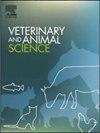不同κ-酪蛋白基因型及转录本对中国荷斯坦奶牛κ-酪蛋白表达及奶牛群改良指标的比较分析
IF 1.9
Q2 AGRICULTURE, DAIRY & ANIMAL SCIENCE
引用次数: 0
摘要
κ-酪蛋白(κ-CN, CSN3)变异影响牛奶成分、加工、乳蛋白含量和产奶量。CSN3突变是否会影响自身基因的表达,进而影响酪蛋白含量和产奶量,目前尚不清楚。为了解决这个问题,我们进行了κ-CN基因型和转录本对κ-CN表达和DHI指数影响的实验。通过PCR测序、PCR- rflp、western blot和PCA分析,κ-CN BB基因型中κ-CN的表达量显著高于AA基因型和AB基因型(P <; 0.05)。对于杂合型κ-CN AB基因型,转录本A与转录本B的κ-CN表达量差异无统计学意义(P >; 0.05)。与κ-CN基因型相比,κ-CN转录本更适合作为乳蛋白含量和产奶量等奶牛群体改善(DHI)指标的分类指标。因此,κ-CN变异体确实会影响牛奶中κ-CN的含量,但不能确定κ-CN B变异体的含量一定高于κ-CN A变异体,也不能确定牛奶蛋白含量的差异规律。这种现象可能与κ-CN非编码区发生的调控变化有关。本文章由计算机程序翻译,如有差异,请以英文原文为准。
Comparative analysis of κ-casein expressions and dairy herd improvement indices in Chinese Holstein cows of diverse κ-casein genotypes and transcripts
κ-casein (κ-CN, CSN3) variants affect milk composition, processing, milk protein content and milk yield. Whether the CSN3 mutation affects the expression of its own genes, which in turn affects the casein content and milk production, is unknown. To address this question, we conducted an experiment on the effects of κ-CN genotypes and transcripts on κ-CN expression and DHI indices. Through PCR sequencing, PCR-RFLP, western blot and PCA analysis, the expression of κ-CN in the κ-CN BB genotype was significantly greater than that in AA genotype and AB genotype (P < 0.05). For the heterozygous κ-CN AB genotype, there was no significant difference in the expression level of κ-CN between transcript A and transcript B (P > 0.05). The κ-CN transcripts were more suitable than the κ-CN genotypes as classification indicators associated with dairy herd improvement (DHI) indices such as milk protein content and milk production. Therefore, κ-CN variants do affect the content of κ-CN in milk, but it cannot be confirmed that the content of the κ-CN B variant is definitely higher than the κ-CN A variant, nor can the difference law in milk protein content be confirmed. This phenomenon may be related to regulatory changes caused by in the non-coding region of κ-CN.
求助全文
通过发布文献求助,成功后即可免费获取论文全文。
去求助
来源期刊

Veterinary and Animal Science
Veterinary-Veterinary (all)
CiteScore
3.50
自引率
0.00%
发文量
43
审稿时长
47 days
 求助内容:
求助内容: 应助结果提醒方式:
应助结果提醒方式:


